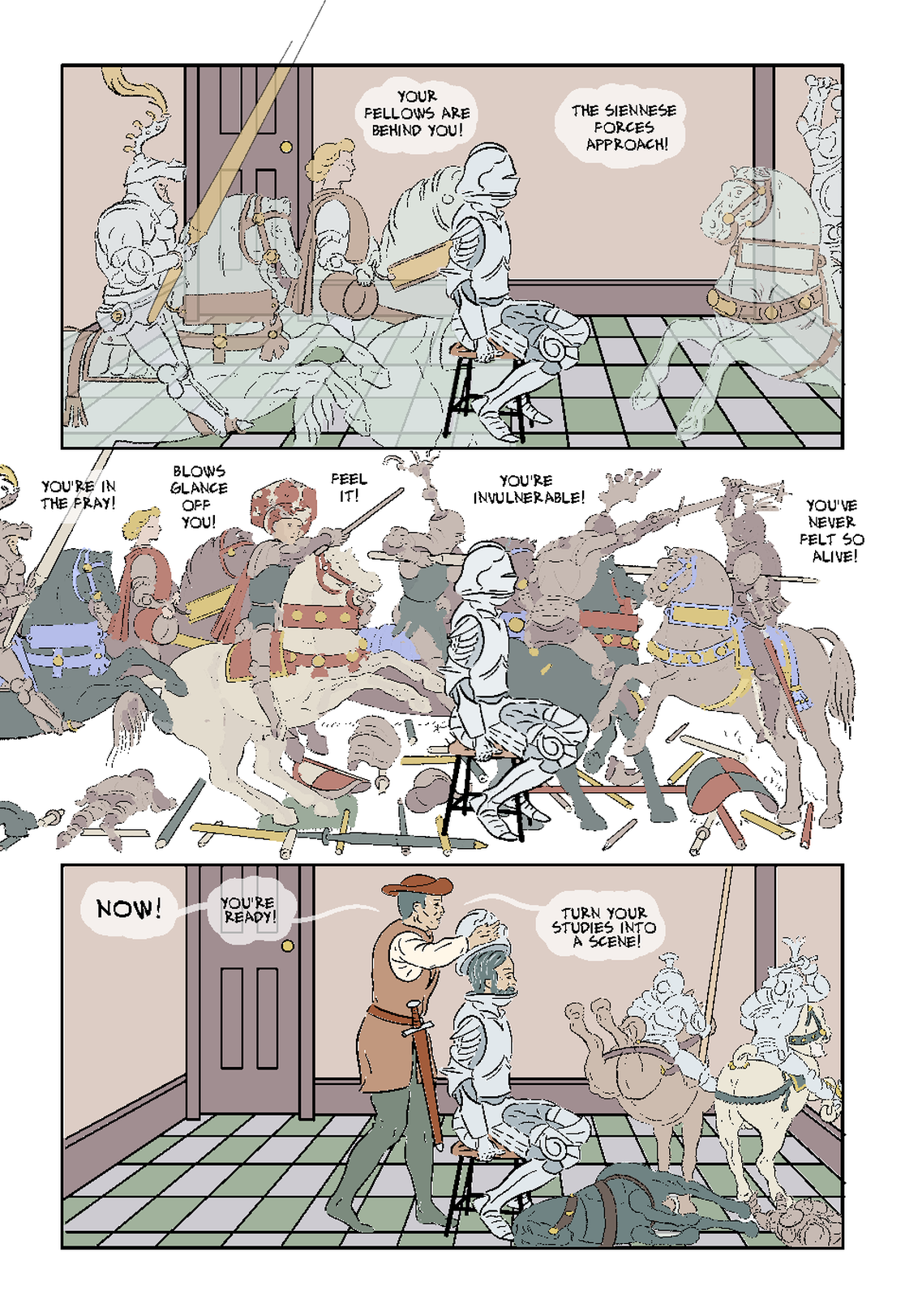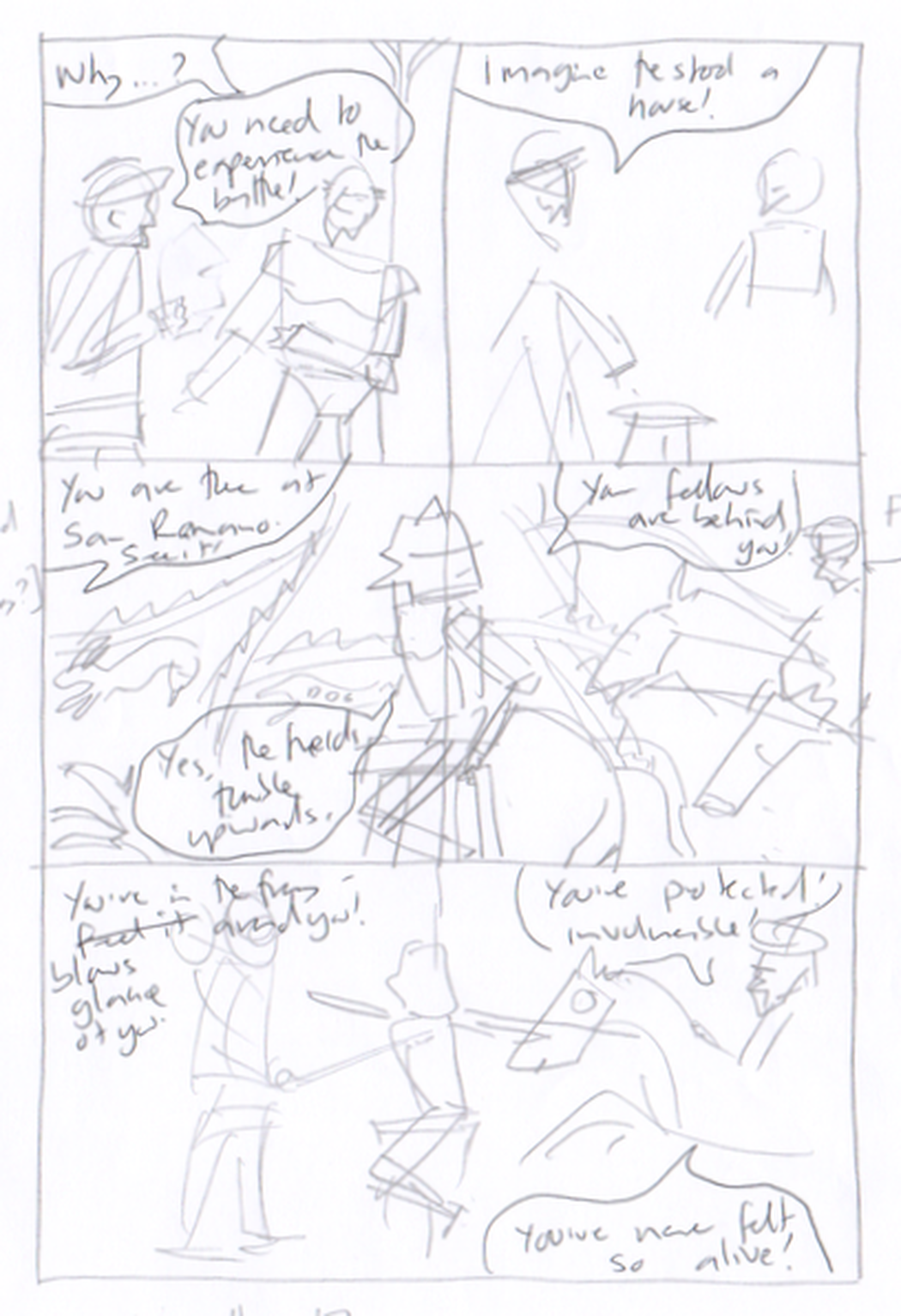|
I have previously posted on this sequence at earlier stages. This is near the end of the story, and Rocco (the patron's major demo) has got Uccello to put on armour he has for reference (miraculously it is a perfect fit!), and a bit to 'put him into the battle' and enable him to bring his studies together into the battle scene(s). My plan was that these pages would have essentially the same shot of Uccello on a stool, but overlaid with his imagined images of the battle. I decided to extend this sequence to two pages, one advantage of this is that I was able to use row-wide panels, reflecting the aspect ratio of the paintings the story is about. I was able to draw the room background and paste it into the other panels, and the same with Uccello on the stool. I had the pages drawn, and still had to add the details of Uccello's imagining of the battle. The next task was to overlay on panel 3 the first stage of Uccello's imagining of (not yet the battle itself) the scene of the battle. I wanted this to reflect an earlier panel (below, from Page 11) where Uccello had tried to map out in perspective the battle scene. I pasted in Uccello's perspective space, from page 11 (above), overlaying this on the already colour flatted page. I duplicated the blue perspective layer in white and placed it under the blue, to make these lines stand out. I made use of a lot of the special tools like pencil, pastel and airbrushes, and brushes for specific effects such as grass and trees. It was helpful to have a chance to explore these various tools, and in many ways the effect is successful, but perhaps too incongruous with the overall style. I decided to leave this for the time being, and work on the, more complex, second page of this scene. The second page would have overlaid scenes of the battle - drawn from Uccello's paintings, as sketched in below. It’s worth noting here that I changed, from my original roughs, the direction Uccello was facing. The position of the characters and stool in the room, in terms of a cinematic continuity, suggested (keeping a fixed camera) Uccello would be facing to the left. This is of course goes against the conventional reading direction (in the West) from left to right, but it would have fitted with the power relations in the scene, that Uccello was feeling somewhat disempowered and disoriented. However, swapping it to have him facing right was ultimately a far better approach, because it let the elements of the Uccello painting face in the same direction, and indeed, in that the battle moves from left to right.  I had already inked/pasted elements on to the page, including the flats. It is more traditional to leave flatting until the drawing/inking stage is complete, but I knew I wanted the background flatted in, to overlay the imagined battle scenes over. The exception to this was the middle panel, which represents his total immersion the imagined battle, and so would have no visible trace of his actual surroundings in the patron's room. In the end I was able to take the battle elements directly from Uccello's painting (The Battle of san Romano - 1st of a series of three paintings, this one in London). This was good because my underlying reason for the comic is to reimagine and illuminate the process of making the paintings, and this then showed elements of the battle imagined before being realised in the final design. I pasted the painting into Manga Studio as a reference layer to overdraw. In the first panel I chose and carefully placed elements of the images that reflected my text: his 'fellows behind him', and the opposing forces 'approaching'. In the second panel, I used all the foreground figures from the painting, again, carefully arranging these in the panel for the best composition. This was somewhat constrained by wanting to be true to Uccello's composition, and the figures needing to be broadly to scale in relation to the repeated image of Uccello. I did consider reducing the size of the armoured figure of Uccello - this would have given a sense of the scale of the battle in relation to him, but in the end, I decided that the visual elegance of keeping the Uccello figure the same outweighed the slight mis-scale of the figures. Removing the border of this panel helped in a number of ways: it gave me more space for the figures, and to work the lettering around them, it also made the composition look better, and most importantly it reflected a shift for Uccello, from being in a room imagining a battle, to actually being there, in open space, at the battle. The cropping of the furthest left figure, partly came out of getting the best arrangement of the other figures in relation to the fixed position of Uccello, but it fits with what Rocco (out of camera) is telling Uccello, that he is safe with the Florentine forces behind him: we see only a single opposing horseman, whereas Uccello's 'fellows behind [him]' extends off the page, as if to infinity...  For the third panel (above), I wanted to suggest Uccello's vision lingering, and slowly 'evaporating', as Rocco removes the helmet from him. After some study of the Uccello paintings, I decided to base the imagined images on Uccello's second painting (below left) in the series, specifically the bottom right of it (below, right), which shows a fallen horse its armoured rider, and two riders racing away from the scene. The placing suited the sequentiality within my panel , where (working from top right) we have seen the empty room, then Rocco bringing Uccello back to it through removing the helmet, and finally, we see his vision in the process of leaving him. It's worth saying something here about the rendering. I wanted the imagined figures and horses to seem a bit less real and tangible than the room and Uccello, and I used a number of techniques to achieve this, including drawing them in 'pencil' and colouring them (at times) on translucent layers letting the background show through. That's easier to say than it was to do though! I have a number of 'pencil' brushes for Manga Studio, but it still was not easy to find one that (within an inked and coloured page) looked obviously like pencil, and not just grey lines. I chose the most suitable, and worked on a Monochrome rather than Greyscale layer. While this didn't clearly scream ‘pencil', it did give a less dark and tangible line than inking, (and is not as pixelated as the fairly low res version posted above). This technique proved slow and laborious to colour flat, as the colour would leak through any weak points in the line, so I had to do a considerable amount of drawing in lines with a marker before filling, and still had to erase numerous overflows. Possibly working with an enlarged view of the picture didn't help, as, in hindsight, I was possibly fixing things most readers either wouldn't have spotted or registered as wrong.
It’s not usual to add colour flats while the pages are unfinished (perhaps reflecting the ‘Ford Factory’ division of labour in mainstream comics), but it worked here to add the flats, as I wanted the imagined images to look ghostly, and show the background behind them. To this end I overlaid a further colour flat layer, with reduced opacity, and coloured the images on that. This also gave the advantage that I could modulate the level of opacity for the best balance on the finished colour layer. The imagined images don’t look quite translucent enough in the version above, but I have since gone back and fixed that. Panel 2 though, required a slightly different approach, as here i was trying to convey that he has now forgotten his actual surroundings in the patron’s room, and is immersed in the battle scene. However I still wanted the battling figures to look less real and solid than the figure of Uccello. First of all I created a new flat layer and coloured all the battling figures in a flat grey/brown - this gave quite a pleasing silhouette effect. Over this I added a reduced opacity coloured layer to colour the individual details - this achieved the intended effect of both greying the colours, and retaining the silhouette effect slightly. To add some subtle modelling I went back and applied a darker grey/brown to parts of the ‘under-draw’ layer. This page has been perhaps the most work of any, but I think has solved a problem I was leaving off, as is suitably impactful for this climactic scene. I will also be able to use my drawn battling figures for my versions of Uccello’s developing designs for the painting, on the next pages.
0 Comments
Leave a Reply. |
AuthorGraham Johnstone ~ Master of Design - Comics and Graphic Novels student 2016-17 Archives
August 2017
Categories |







 RSS Feed
RSS Feed